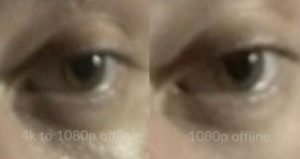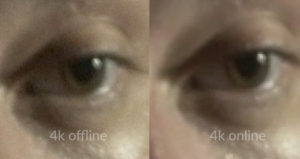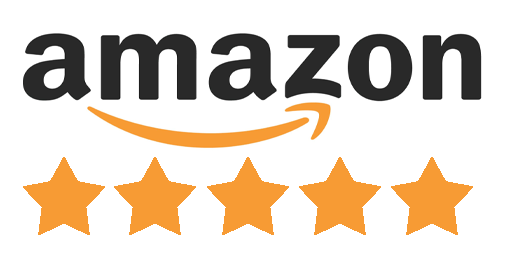In recent years, 4K/UHD (Ultra HD) content and devices have taken the world by storm. This is such a popular feature that we have actually discussed it in-depth in a past article. For many, this has been the natural progression of things. To improve their viewing experiences at home, it was an obvious decision to upgrade from their former Full-HD (1080p) setups. For others, this decision holds much more weight.
Whether it is a lack of expendable income, concerns about longevity, or simply a lack of interest, there are plenty of individuals who have yet to move on to a full 4K setup. For many, their concerns stem from the potential cost of building a full setup to run 4K/UHD content- after all, a 4k television, 4k blu-ray player, and the videos to play on these devices all cost money. If cost is an issue, you could benefit by upgrading your devices piecemeal.
The premise of having a full 4K/UHD setup is obviously tempting, as it should be. These devices provide beautiful, entrancing viewing experiences that are notable improvements over their traditional Full-HD counterparts. However, each component of a 4K setup has its own benefits; they all serve different purposes which, even alone, serve as upgrades to a traditional setup.
4K/UHD Televisions
Many 4K/UHD Televisions have the unique feature of upscaling their video output to higher resolutions. Upscaling refers to the act of taking footage that is rendered at a lower resolution than what is native to the television (so in this case, it could be 1920x1080 or 1080p footage) and rendering it at or near the expected resolution (UHD or 3840x2160).
Upscaling
I need to be clear here and stress that this does not produce the same level of quality that one would experience by playing UHD content on the same 4K television. Upscaling is an in-depth process that, in essence, uses various algorithms to automatically take videos (which are long sequences of images, or ‘frames’, for our purposes) and increase the number of pixels that make up each frame. This needs to happen incredibly quickly in order to not be noticeable by the viewer.
[caption id="attachment_1575" align="aligncenter" width="300"] Figure A: 1080p - Zoomed in 200%.[/caption]
[caption id="attachment_1576" align="aligncenter" width="300"]
Figure A: 1080p - Zoomed in 200%.[/caption]
[caption id="attachment_1576" align="aligncenter" width="300"] Figure B: 1080p image upscaled to 4k. Zoomed in 200%.[/caption]
[caption id="attachment_1577" align="aligncenter" width="300"]
Figure B: 1080p image upscaled to 4k. Zoomed in 200%.[/caption]
[caption id="attachment_1577" align="aligncenter" width="300"] Figure C: True 4K, zoomed in 200%.[/caption]
Figure C: True 4K, zoomed in 200%.[/caption]
The resulting image is dramatically improved from that of standard 1080p, but still not nearly as detailed as true 4K. Figures A-C shows a highly zoomed-in (200%) comparison of the same image at 1080p, Upscaled 4K, and Native 4K. The effects of upscaling are clear: the native image is highly pixellated, with a great deal of 'tessellation' (the jagged edges around objects). The upscaled image is much less jagged, and while it is blurry it is still a drastic improvement over its predecessor. The final image of the three, the Native 4K image, clearly has a greater amount of detail than the others due to its incredibly fine resolution. If the difference is not noticeable, look a bit closer at the screen. From distances, they appear more similar due to their size, while on a large television they are extremely noticeable.
This is perhaps the most noticeable means through which a 4K television can serve as an upgrade without opting for additional upgrades. Even non-4K video will suddenly look better upon acquiring this new television! Aside from that, many streaming services such as Hulu and Netflix offer the option to stream 4K/UHD content, although one should ensure that their internet connection is fast enough to handle it prior to making the commitment.4K Blu-ray Players Without 4K Televisions?
There is one upgrade on the path to a full Blu-ray setup that could potentially be more noticeable than all others- 4K Blu-ray players. Even without with a 4K Television, these could significantly improve one's viewing experience. There are some caveats I would put in place here, however. While a 4K Television will provide a blanket improvement on video quality through upscaling, many 4K Blu-ray players offer the option of improving video quality through 'downscaling'. Put simply, downscaling is a process wherein an image is rendered at a higher resolution and then output at a lower one. While this might sound pointless, there is a notable difference. These images obviously do not have the full, incredible detail one would see in a 4K image. At the same time, a downscaled video will typically look better than the alternative 1080p version. There are other considerations to make, such as the source of videos; streamed videos see a loss in quality no matter what, simply as a result of them downloading over time. However, that is as much an issue of internet connection speeds as it is hardware. For Blu-rays specifically, downscaling can drastically improve image quality. [caption id="attachment_1567" align="aligncenter" width="300"] A comparison between 4K downsampled (left) and standard 1080p (right). Source: https://www.premiumbeat.com/[/caption]
[caption id="attachment_1568" align="aligncenter" width="300"]
A comparison between 4K downsampled (left) and standard 1080p (right). Source: https://www.premiumbeat.com/[/caption]
[caption id="attachment_1568" align="aligncenter" width="300"] A comparison between 4K Offline (Blu-ray) and 4K Streaming (YouTube). Source: https://www.premiumbeat.com/[/caption]
Other considerations need to be made when purchasing these devices. Additional hardware components, the quality of the upscaling and downscaling from devices, internet connection speeds, and the films themselves are all important. The ultimate point of this is to show that you can benefit from purchasing a new television or Blu-ray player now- even if you do not have a full setup ready to go. Some great examples of devices that have these features are:
A comparison between 4K Offline (Blu-ray) and 4K Streaming (YouTube). Source: https://www.premiumbeat.com/[/caption]
Other considerations need to be made when purchasing these devices. Additional hardware components, the quality of the upscaling and downscaling from devices, internet connection speeds, and the films themselves are all important. The ultimate point of this is to show that you can benefit from purchasing a new television or Blu-ray player now- even if you do not have a full setup ready to go. Some great examples of devices that have these features are:


 When the term "home theater system" first originated, it was based on creating a theater-like experience with the use of a surround sound audio system. Over the years, the term Home Theater has taken on new meaning, encompassing all types of media - from music and movies to home video, photo albums and more. What was once the ability to enjoy great sound has transformed into endless entertainment possibilities. So what exactly does a Smart Home Theater System do? Practically everything!
Thanks to the advances with television and Blu-ray technology in recent years, we're now able to consolidate and centralize media from multiple devices on our home network. Rather than acting only as a devices to watch Cable TV or movies, TVs and Blu-ray players have morphed into smart media hubs equipped with features like built-in Wi-Fi, voice and motion recognition, and the ability to make video calls with people halfway around the world. You can download and use apps that allow you to keep up with sports, surf social media, stream 4K Ultra-HD movies, listen to streaming music from thousands of channels, and even play video games. If your Blu-ray player or Smart TV are equipped with DLNA compatibility, you can watch movies or listen to your music playlist from a laptop in your bedroom, wirelessly, directly on your TV and surround sound system. The days of burning discs and messy cables are over - everything can be handled wirelessly through Wi-Fi and Bluetooth.
Screen mirroring is another great feature that allows you to share your smartphone or tablet's screen with your Smart TV. Let's say you want to watch a 45 minute documentary from the web on your big screen - just connect your phone with the TV, start playing the video on your phone and it will appear on your TV in full resolution with surround sound. This allows you to watch videos on a much larger scale, with improved audio and without the need to search for the video using the TV or Blu-ray Player's web browser (which can often be slow and fussy).
Many Smart TVs and Blu-ray Players are now featuring dual-zone audio, which sometimes goes by different names. What this feature does is utilize a 7.1 channel audio system to set 2 channels to a different area. A great example of this would be to use two channels for the speakers for your outdoor patio, bar, or a basement. What's more is that while you can listen to your playlists from other devices, you can even use your smartphone as a remote control with many TVs and players. This means that when you're outside having a party (and listening to music that's both inside and outside your home thanks to dual-zone audio) you can use your phone's screen to access the user interface from the TV or Blu-ray player, select music, skip tracks, adjust the volume and more! If that's not impressive, we're not sure what is.
Many people aren't aware of the true power of their Smart TVs or Smart Blu-ray Players. They can do a lot and they can do it all wirelessly. The technology is becoming more flexible, more capable, faster and more complete. When you're ready to consolidate your digital media for easy wireless access and playback on your TV and surround sound system, look into upgrading to a Smart Home Theater. For even more flexibility and universal use with any voltage, any TV and discs from anywhere in the world, look into purchasing a
When the term "home theater system" first originated, it was based on creating a theater-like experience with the use of a surround sound audio system. Over the years, the term Home Theater has taken on new meaning, encompassing all types of media - from music and movies to home video, photo albums and more. What was once the ability to enjoy great sound has transformed into endless entertainment possibilities. So what exactly does a Smart Home Theater System do? Practically everything!
Thanks to the advances with television and Blu-ray technology in recent years, we're now able to consolidate and centralize media from multiple devices on our home network. Rather than acting only as a devices to watch Cable TV or movies, TVs and Blu-ray players have morphed into smart media hubs equipped with features like built-in Wi-Fi, voice and motion recognition, and the ability to make video calls with people halfway around the world. You can download and use apps that allow you to keep up with sports, surf social media, stream 4K Ultra-HD movies, listen to streaming music from thousands of channels, and even play video games. If your Blu-ray player or Smart TV are equipped with DLNA compatibility, you can watch movies or listen to your music playlist from a laptop in your bedroom, wirelessly, directly on your TV and surround sound system. The days of burning discs and messy cables are over - everything can be handled wirelessly through Wi-Fi and Bluetooth.
Screen mirroring is another great feature that allows you to share your smartphone or tablet's screen with your Smart TV. Let's say you want to watch a 45 minute documentary from the web on your big screen - just connect your phone with the TV, start playing the video on your phone and it will appear on your TV in full resolution with surround sound. This allows you to watch videos on a much larger scale, with improved audio and without the need to search for the video using the TV or Blu-ray Player's web browser (which can often be slow and fussy).
Many Smart TVs and Blu-ray Players are now featuring dual-zone audio, which sometimes goes by different names. What this feature does is utilize a 7.1 channel audio system to set 2 channels to a different area. A great example of this would be to use two channels for the speakers for your outdoor patio, bar, or a basement. What's more is that while you can listen to your playlists from other devices, you can even use your smartphone as a remote control with many TVs and players. This means that when you're outside having a party (and listening to music that's both inside and outside your home thanks to dual-zone audio) you can use your phone's screen to access the user interface from the TV or Blu-ray player, select music, skip tracks, adjust the volume and more! If that's not impressive, we're not sure what is.
Many people aren't aware of the true power of their Smart TVs or Smart Blu-ray Players. They can do a lot and they can do it all wirelessly. The technology is becoming more flexible, more capable, faster and more complete. When you're ready to consolidate your digital media for easy wireless access and playback on your TV and surround sound system, look into upgrading to a Smart Home Theater. For even more flexibility and universal use with any voltage, any TV and discs from anywhere in the world, look into purchasing a  One of the last features you might expect to see from a Region Free Blu-ray Player is the ability to play video games, but Sony has just changed all that. As of the time of this writing, all 2016 Sony Blu-ray Players are equipped with Playstation Now access.
As a leader in both the gaming and home electronics industry, Sony made an unprecedented move by combining two of their biggest talents - home theater and gaming - into all of their new Blu-ray models, giving consumers an improved value for their dollar and leaving their competitors unable to compete. After all, Sony is the only Blu-ray manufacturer who also has their own gaming system, therefore, the only manufacturer (as of right now) able to make this ingenious power move.
If you're still wondering how they've managed to do this (or what Playstation Now is and how it works) keep reading.
Playstation Now is a cloud-based gaming service, based off the ever-popular Playstation Gaming Console. It allows users to subscribe and enjoy streaming gaming not only from the Playstation Console itself but also from other Sony devices, with Sony Blu-ray Players being the latest addition. It works like any internet-based subscription, and subscribers can log-in and play from anywhere (with an enabled device). Users can even save their game progress on one device and then continue their game on a different device. All you need to play is your Region Free Sony Blu-ray Player and a Playstation DualShock 4 controller. You can plug the controller directly into the Blu-ray Player's frontal USB port and game away!
There are different levels of subscriptions available which include both short-term and long-term game rentals. You can subscribe and pay for nothing more than the games they choose to rent, or you can subscribe with a monthly or quarterly subscription which allows for unlimited access to all available games. Prices for monthly subscriptions start at $19.99 per month for unlimited service. Currently, there are over 400 games available on the Playstation Now service with more being added each week.
The only downside is that the titles currently offered are all Playstation 3 games, which is primarily due to meeting the needs of the average user - as well as global streaming media standards. Sony wants to keep data transfer rates that are acceptable for a majority of internet users and not just those with ultra-fast internet speeds. In order to achieve quality gaming, Sony has optimized Playstation Now to work with the average internet connection but it's recommended that users have a 5mb per second for good quality experience. In the future, as technology allows and as internet speeds continue to improve, newer titles will be added.
As far as we're concerned, Sony's move of combining Playstation Now with their Blu-ray Players offers a truly powerful and convenient platform; one that says a lot about where the future of gaming is headed. They've literally shed a completely new light on both home theater and gaming.
As specialists in Region-Free Blu-ray players, we naturally carry the Region Free Sony Blu-ray Players with Playstation Now. All of the latest 2016 models are in stock and ready to ship today. If you're interested in purchasing one or learning more, check out
One of the last features you might expect to see from a Region Free Blu-ray Player is the ability to play video games, but Sony has just changed all that. As of the time of this writing, all 2016 Sony Blu-ray Players are equipped with Playstation Now access.
As a leader in both the gaming and home electronics industry, Sony made an unprecedented move by combining two of their biggest talents - home theater and gaming - into all of their new Blu-ray models, giving consumers an improved value for their dollar and leaving their competitors unable to compete. After all, Sony is the only Blu-ray manufacturer who also has their own gaming system, therefore, the only manufacturer (as of right now) able to make this ingenious power move.
If you're still wondering how they've managed to do this (or what Playstation Now is and how it works) keep reading.
Playstation Now is a cloud-based gaming service, based off the ever-popular Playstation Gaming Console. It allows users to subscribe and enjoy streaming gaming not only from the Playstation Console itself but also from other Sony devices, with Sony Blu-ray Players being the latest addition. It works like any internet-based subscription, and subscribers can log-in and play from anywhere (with an enabled device). Users can even save their game progress on one device and then continue their game on a different device. All you need to play is your Region Free Sony Blu-ray Player and a Playstation DualShock 4 controller. You can plug the controller directly into the Blu-ray Player's frontal USB port and game away!
There are different levels of subscriptions available which include both short-term and long-term game rentals. You can subscribe and pay for nothing more than the games they choose to rent, or you can subscribe with a monthly or quarterly subscription which allows for unlimited access to all available games. Prices for monthly subscriptions start at $19.99 per month for unlimited service. Currently, there are over 400 games available on the Playstation Now service with more being added each week.
The only downside is that the titles currently offered are all Playstation 3 games, which is primarily due to meeting the needs of the average user - as well as global streaming media standards. Sony wants to keep data transfer rates that are acceptable for a majority of internet users and not just those with ultra-fast internet speeds. In order to achieve quality gaming, Sony has optimized Playstation Now to work with the average internet connection but it's recommended that users have a 5mb per second for good quality experience. In the future, as technology allows and as internet speeds continue to improve, newer titles will be added.
As far as we're concerned, Sony's move of combining Playstation Now with their Blu-ray Players offers a truly powerful and convenient platform; one that says a lot about where the future of gaming is headed. They've literally shed a completely new light on both home theater and gaming.
As specialists in Region-Free Blu-ray players, we naturally carry the Region Free Sony Blu-ray Players with Playstation Now. All of the latest 2016 models are in stock and ready to ship today. If you're interested in purchasing one or learning more, check out  If you own a Sony Blu-ray Player or are in the market for a region-free Blu-ray system, there's no better value right now than Sony. Not only do they deliver top of the line audio/video performance, they've also put together the Sony Entertainment Network - an amazing lineup of free apps and streaming media that are available to enhance your home theater experience.
From games and news to humor and cult movie channels, there's a wide variety to choose from and best of all, many apps are free! Packed with both video and music applications, The Sony Entertainment Network allows you to log in with one account to access your favorite apps both at home and on the go. Once you've signed up for a free account, you can also access Sony's Music Unlimited and Video Unlimited services.
Video Unlimited operates similar to an On-Demand cable service, allowing you to purchase or rent downloadable content from a huge list of movies, tv shows and specialty programs. If you have a Sony Blu-ray Player, the Video Unlimited Service is a streaming product
The Music Unlimited provides access to millions of songs in their global catalog and dozens of add-free channels to stream your favorite tunes with no annoying ads. There are two levels of Music Unlimited Service - Basic ($3.99) and Premium ($9.99). Both offer a feature similar to many of the most popular streaming audio platforms that delivers music catered to your specific tastes. Additionally, the service has the ability to scan existing audio files from your devices to determine similar music that suites your tastes. Premium users have the ability to create and manage playlists, plus access even more premium audio channels.
If you're curious about flexibility, have no worries - the Music Unlimited Service is available on the SOny Tablet, Android tablets and Android mobile phones, Sony PS3, Bravia Televisions, Sony internet TV, and PCs. No matter where you are or what device your using, you can quickly and easily access, modify and listen to your favorite music with ease.
Want to get our feet wet? Then you should
If you own a Sony Blu-ray Player or are in the market for a region-free Blu-ray system, there's no better value right now than Sony. Not only do they deliver top of the line audio/video performance, they've also put together the Sony Entertainment Network - an amazing lineup of free apps and streaming media that are available to enhance your home theater experience.
From games and news to humor and cult movie channels, there's a wide variety to choose from and best of all, many apps are free! Packed with both video and music applications, The Sony Entertainment Network allows you to log in with one account to access your favorite apps both at home and on the go. Once you've signed up for a free account, you can also access Sony's Music Unlimited and Video Unlimited services.
Video Unlimited operates similar to an On-Demand cable service, allowing you to purchase or rent downloadable content from a huge list of movies, tv shows and specialty programs. If you have a Sony Blu-ray Player, the Video Unlimited Service is a streaming product
The Music Unlimited provides access to millions of songs in their global catalog and dozens of add-free channels to stream your favorite tunes with no annoying ads. There are two levels of Music Unlimited Service - Basic ($3.99) and Premium ($9.99). Both offer a feature similar to many of the most popular streaming audio platforms that delivers music catered to your specific tastes. Additionally, the service has the ability to scan existing audio files from your devices to determine similar music that suites your tastes. Premium users have the ability to create and manage playlists, plus access even more premium audio channels.
If you're curious about flexibility, have no worries - the Music Unlimited Service is available on the SOny Tablet, Android tablets and Android mobile phones, Sony PS3, Bravia Televisions, Sony internet TV, and PCs. No matter where you are or what device your using, you can quickly and easily access, modify and listen to your favorite music with ease.
Want to get our feet wet? Then you should 

